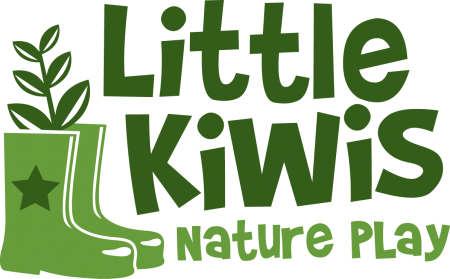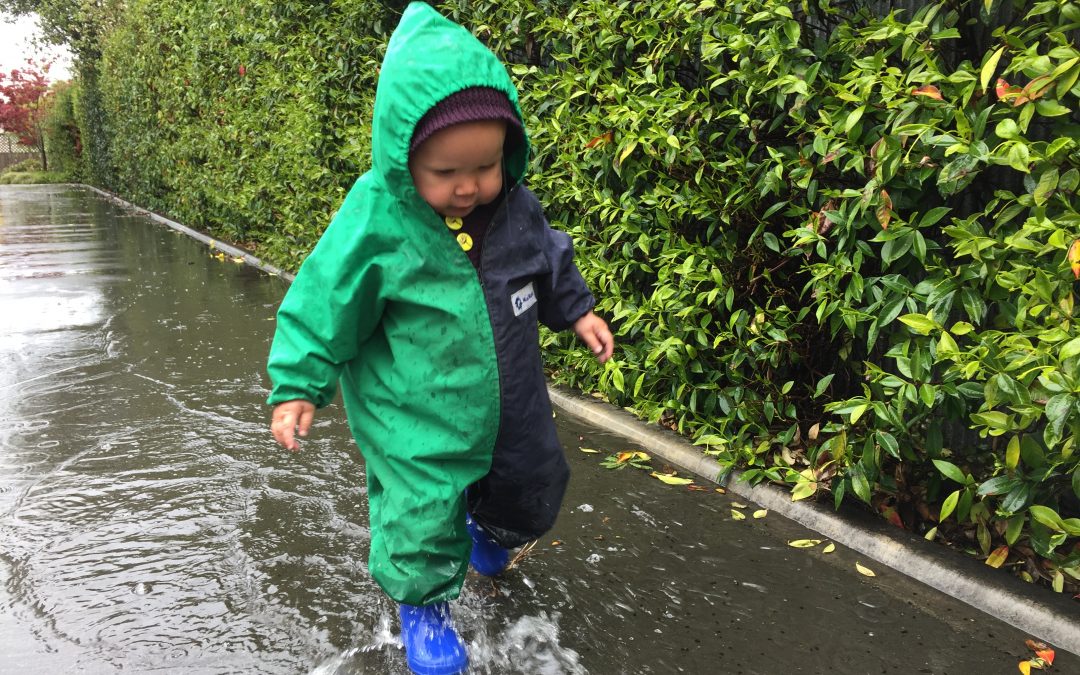I have been asked many times for ideas of what to do with children when it’s raining. My short answer is “Do what you do when it’s not raining”. This response has received a variety of responses back! It’s not meant to be sarcastic, I say it to get people thinking and to generate discussion. This post is aimed at ECE centres but it is also relevant to parents so read on!
Why do we get children to come inside when it rains? Is there something wrong with getting wet? If children have a spare change of clothes, then does it matter if they get wet? What are they gaining from going inside? What are they missing out on from going inside? Does it depend on the educator’s perception of rain or previous experiences? Maybe the educator doesn’t want to get wet or isn’t supplied with adequate clothing themselves? Possibly the educator wants to take their children outside in the rain but is worried about the reaction of families.
These are interesting questions to explore as educators and parents and I am sure there are many other questions that could be added to the list. There is an opportunity for personal reflection here and as a parent I sometimes find myself challenged with this too. Sometimes I don’t feel like going outside and getting wet when my children are wanting to play outside in the rain. Why is it that I don’t want to get wet? If I’m honest I don’t want to have wet jeans for the rest of the day! It seems silly as I write it but that’s what I sometimes think!
Questioning those thoughts or finding a solution to the challenges can help support you to move through these little ‘rain hurdles’ and get outside and play. I often think back to experiences that I had in the rain as a kid. I have a wonderful memory from when we were on holiday in the Marlborough Sounds, New Zealand. We were down at the mudflats by the beach, it was pouring with rain and we were squelching the mud between our toes. There was the smell of the stinky mud, the feeling of the mud oozing between our toes and creeping up our legs and the sound of rain pitter pattering on the sea. There was also the sound of the rain on our rain jackets which was so loud when we had our hoods on. We observed that some rain drops made little circles and some made bigger circles when they landed on the water. I was having a full sensory experience. For me, thinking back to these kinds of experience are enough to motivate me to get outside in the rain with tamariki. But that might not work for everyone so I have come up with 5 tips for getting outside in the rain that help address some of the questions covered above.
Here are my 4 tips for getting outside in the Rain:
- Get your team on board: Perhaps it is an embedded culture at your education centre that when it starts to rain the children come inside. If this is the case, then you could bring this up at your next team meeting – Why is it that we bring the children inside when it rains? Or perhaps you could start with a question: ‘What is your best memory of the rain as a child?’ Start a conversation and get your team thinking and talking about the possibility of playing outside in the rain. What would need to happen to make it happen? What would that look like and how would people feel about it?
- Get your families on board: Talk to your centre families about the wonderful play and learning experiences they can have in the rain. Share information about what is required to engage in happy play outside in adverse weather. Include a reminder of what clothing needs to come with them each day to make this possible. Maybe you have a supply of spare wet weather gear for children to use.(Clothing list further down).
- Be a wicked weather role model: We all know that children are like sponges! If we can show them an appreciation for the weather, then they will pick up on this. This one is about having the right frame of mind. What do you need to do to change your state of mind? Maybe having the right clothing so that you stay warm will help your state of mind. What can you tell yourself – the experiences the children will have are part of a wonderful inquiry of learning. Try focusing on the positive e.g. ‘This rain is great for the plants as it helps them grow’ or ‘I love the sound of rain on the tin roof’. Did you know that you can trick your mind with positive thoughts even if you aren’t feeling positive about something? Test it out! Depending on your thoughts will depend on where you need to take this internal conversation.
- Have the right clothing: This is not just for the children but the teachers and educators too.
- Rain jackets are awesome for long periods of enjoyment in wet conditions. Hoods are useful for stopping rain from going down the back of your neck and can also act as a heater for your head.
- woollen hats are great in the winter or on a particularly cool day. We can loose 80% of heat through our head so a hat will help reduce heat loose and keep us warmer for longer
- gloves are great in winter too. They can make it a little harder to do things but it can turn into a problem-solving activity for children by using gloves. Woollen gloves are generally enough in New Zealand city winter conditions. For those in rural or inland locations where the temperature can be a lot colder I would suggest thick water proof / water resistant gloves. You can sometimes find woollen gloves in opportunity shops or crafts markets. For waterproof gloves the best places are often ski shops – or a second-hand ski shop!
- Warm layers become essential with cooler temperatures. Wool, merino and thermals are best for warm layers as they keep you warm even when they get wet. Cotton is not that great when it gets wet as it can make you cold so that’s good to be aware of if some children are going outside without a rain jacket and with only cotton layers. Farmers half price sales are great value for woollen, merino and thermal clothing purchases.
- I also recommend over trousers for winter. What tends to happen when only wearing a rain jacket is the rain runs down the rain jacket and then at the bottom it has nowhere to go so it runs onto your trousers! I like mudmates.co.nz for some cool New Zealand made over trousers and wet weather clothing. You can also get along to places like Farmers and Para Rubber or a local opportunity shop.
- What if your tamariki can’t afford it? Fundraising for some outdoor clothing, doing some opp shopping or asking families if they have any spare that they would like to donate are some ideas to help make it happen.
There you have it. Hopefully there is something in there to help you get out in the rain with your tamariki! There are many things worse than getting wet, so what are you waiting for – Get out in the rain and make some mud pies!

